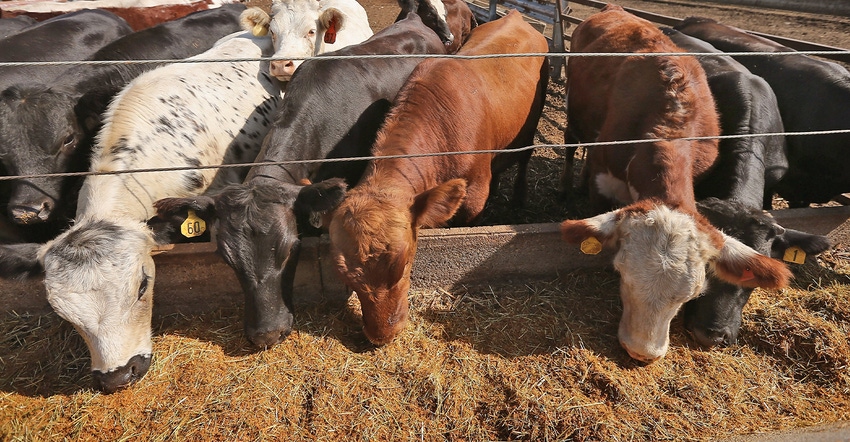September 12, 2019

With volatile livestock market prices, farmers now have more appealing insurance underwritten by the USDA. The federally subsidized protection has been revised and simplified.
Ryan Milhollin, University of Missouri Extension economist, says that while crop farmers are protecting against losses, livestock producers haven't done as much.
USDA's Risk Management Agency heard complaints and revised Livestock Risk Protection (LRP), Milhollin says. Higher subsidies on premiums may especially appeal to farmers growing feeder calves.
Increase in coverage
A policy covers unexpected lower sale prices. When prices fall, a policy softens loss. Buyers can obtain full or partial coverage. Lower protection costs less.
New policies fit small producers and are more flexible. The policies partially cover price shortfalls below expected prices. Percent of coverage can be adjusted.
The premium subsidy, which had been 13%, now ranges from 20% to 35%, depending on the plan chosen.
Missouri farmers avoided complexities of the old system that left them exposed to risk. This year, Missouri farmers insured only 5,000 head of feeder calves, down from 30,000 in 2014.
While USDA underwrites LRP, policies come only from local insurance agents. Usually, they also sell crop insurance.
"Local agents help farmers pick a plan to fit their situation," Milhollin says.
Protection benefits
There are many LRP advantages, Milhollin says. Risk management protects from financial loss when sale prices drop. Most appealing, USDA helps pay premiums.
LRP provides protection similar to a "put option" on the futures market. But it's easier and more flexible. Policy coverage fits the number of weeks a calf herd is held. There are no broker fees.
LRP insurance covers only market prices. It doesn't compensate for other losses, such as death by disease or lightning.
Further, ending values aren't based on actual sale prices. Payments rely on indexes and market data sets. "Farmers need to understand their local markets," Milhollin says.
LRP covers much more than feeder calves. But fewer farmers retain feeders into the feedlot. LRP also covers hogs and sheep. A separate risk plan covers dairy.
MU agricultural economists, including Milhollin, wrote MU Extension publication G459, which explains LRP and other livestock and dairy risk plans. The newly updated four-page guide is available for free download at extension2.missouri.edu.
LRP example
The MU guide offers the following example for feeder cattle.
A producer in Missouri plans to sell 100 feeder cattle at a target ending weight of 750 pounds and owns 100% of the cattle. The expected ending value is $140 per hundredweight, and the producer wishes to elect a coverage level of 97%.
The price adjustment factor is 100% for steers, so the coverage price is $135.80 per hundredweight ($140 × 100% × 97%). The USDA reports an actuarial rate of 0.036109.
Here is the premium calculation:
100 cattle × 7.5 cwt = 750 cwt
750 cwt × $135.80 coverage price = $101,850
$101,850 × 100% ownership share (1.0) = $101,850 insured value
$101,850 × 0.036109 actuarial rate = $3,677.70 total premium
$3,677.70 premium − ($3,677.70 premium × 20% subsidy rate) = $2,942.16 farmer paid premium, or $3.92 per cwt
Here is the indemnity calculation:
Using the same information in the above example, at the end of 21 weeks, the actual ending value for feeder cattle is $120 per hundredweight.
$135.80 coverage price − $120 actual ending value = $15.80 per cwt difference
The difference must then be multiplied by the total hundredweight to determine the indemnity payment owed to the producer.
$15.80 per cwt difference × 100 cattle × 7.5 target cwt × 100% share = $11,850 indemnity
Remember the producer had to pay a premium, which means the indemnity received does not fully represent the gain or loss from purchasing the plan. The difference between the indemnity and premium needs to be calculated to find out the net gain or loss from the LRP plan.
$11,850 indemnity − $2,942.16 farmer premium = $8,907.84, or $11.88 per cwt, net gain from LRP plan.
Reach out to your local MU Extension office for help working through similar calculations. LRP is available in Missouri for feeder cattle, fed cattle, lamb and swine.
Source: The University of Missouri Extension is solely responsible for the information provided and is wholly owned by the source. Informa Business Media and all its subsidiaries are not responsible for any of the content contained in this information asset.
You May Also Like




